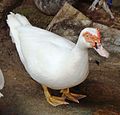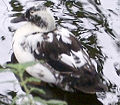- Mulard
-
Not to be confused with Mallard."Moulard" redirects here. For the French wine grape also known as Moulard, see Brun Fourca.
The Mulard (or Moulard) is a hybrid variety of domestic duck produced by crossing a female Pekin with a male Muscovy Duck. Since the domestic Pekin is descended from the Mallard Duck (Anas platyrhynchos) and the Muscovy (Cairina moschata) is a separate species, all Mulards are sterile F1 hybrids. Most are bred through artificial insemination, and are sometimes also called "mule ducks."
The Mulard is mostly produced commercially on farms for meat and for foie gras production. White Muscovies and the Pekin are the two most common pure breeds of duck commercially, and hybrids of the two are hardier and calmer, in addition to exhibiting natural hybrid vigor.[1]
The egg incubation period of the crossings is median between the Mallard and Muscovy, with an average of 32 days. About half of the eggs hatch into mulard ducks[citation needed]. Mulards tend to combine certain traits of the two parent breeds. Due to their Muscovy heritage they produce leaner meat than Pekins; females tend to be raised for meat while males are used for foie gras. Mulards have claws on the feet like a Muscovy, but do not fly and perch, preferring water like Pekins.[2]
Foie gras was traditionally produced primarily with geese, but in the 1960s the majority of farmers began to switch to Mulards. Geese are more expensive to maintain than ducks (they are larger and more aggressive), but the more temperamental Muscovies did not accept the process of gavage (force feeding) as readily as Pekins, and the quality of the foie gras suffered[2]; this problem was avoided by the introduction of mulards. But these hybrids have become extremely common in countries where no foie gras is produced.[3]
Today in France, the leading foie gras producer and consumer, the use of hybrid ducks vastly outnumbers the use of geese. In 2007 there were 35 million Mulard ducks raised in the country, compared with only 800,000 geese.[1] In addition to being raised in Europe and the United States, Mulards are widely raised throughout Southeast Asia.[3]
Gallery
See also
- List of duck breeds
References
- ^ a b Caro, Mark (2009). The Foie Gras Wars. Simon & Schuster. ISBN 9781416556688.
- ^ a b "Committee on Animal Health and Animal Welfare on Welfare Aspects of the Production of Foie Gras in Ducks and Geese". European Commission. December 1998. http://ec.europa.eu/food/fs/sc/scah/out17_en.pdf.
- ^ a b Daghir, N. (2008). Poultry Production in Hot Climates. CABI. ISBN 9781845932589.
Categories:- Duck breeds
- Aves hybrids
- Anseriformes stubs
Wikimedia Foundation. 2010.


